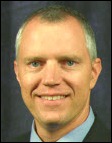The views and opinions expressed are those of the author personally and are not necessarily representative of current or former employers.
Leader the Follow (Part 2) — Identity
Let’s see … where were we? Oh yes, talking about being a follower and the significance of that role. This is a follow up to the last Collective Action post on HIStalk.
Last time I asked for input from readers about what kind of leader you would follow. I received several responses and I will include some of them at the end of this article. Thank you to all who provided feedback — it was insightful and entertaining.
The key to studying followers is similar to the key to studying leaders. It is not about characteristics of a leader or follower. To me, the key is identity. How you see yourself determines your effectiveness.
I agree we need to talk about Meaningful Use, business intelligence, ACOs, and what the next great innovation in healthcare will be. But none of those things can happen without a focus on both leaders and followers and teams they lead.
As I was researching this topic of identity, I came across an interesting term: “metaperceptions.” This is not how you are perceived, but rather how you perceive others perceive you. The difference is slight, but profound.
I have a great example of this from a recent presentation I gave. I was speaking to a crowd of about 100 people here at our hospital at a recent event. It was an EMR project-related event that we themed “Finish Strong,” where I and others presented concepts from Dan Green’s book Finish Strong.
I consider myself a good communicator. I believe I have a gift that allows me to write and present well. As I was presenting, someone in the audience dozed off. I thought right then that her perception of me was that I was a lousy presenter. Instead of continuing as I should have, I got thrown off. I thought they had lost interest and I started rushing through the rest of the presentation, not giving some of the more impactful parts ample time.
Afterwards, I spoke to her and asked her how she liked the event and presentation. She said that she loved it, but had a new baby and was very tired. She made some comments about what was said and how it impacted her. I was blown away. My metaperception was wrong, but that didn’t matter, it impacted my effectiveness.
The root of our identity is only partially based on what others think. It is mostly based on how we view and think about ourselves. Here are some interesting statistics regarding how we think about ourselves.
According to Daniel Amen, MD, a renowned psychiatrist and brain imaging specialist, we have about 60,000 thoughts per day — one every second while we are awake. Ninety-five percent of those thoughts are the same ones we had yesterday (a broken record!) For the average person, 80 percent of those thoughts are negative.
That is incredible. Every day, the average person working in your department or your hospital or living in your home has 45,000 negative thoughts. Whether you are a leader or a follower, whether or not you care about what others say about you, you can do enough damage to yourself to keep yourself from fulfilling your destiny.
How do we combat this? How do we help those around us combat this? If you don’t think this is true about yourself, then you are probably not average, but you know someone who is. While it may not directly impact you, it impacts you in some way.
Let me offer something to you that is a bit unorthodox, but that has literally changed my life. I got this from the late Zig Ziglar, who says that how you see yourself is everything. A part of his program, called Self Talk, includes a laundry list of positive attributes: honest, intelligent, organized, responsible, committed, teachable etc. He offers several paragraphs with affirmations and instructs everyone he works with to say this list of affirmations in the mirror, morning and night, for at least 30 days.
When I first heard this, I thought it was ridiculous, much like what you are likely thinking now. When I tried it, I thought it was stupid and embarrassing. I would not tell my wife. I locked the bathroom door and went through it as fast as possible.
A peculiar thing happened after a couple of weeks. First of all, I finally told my wife, but I also started to become less embarrassed. I started to see that I really was some of these things, and some of them all the time. Other characteristics were just seeds and needed watering.
At the end of 30 days, although I did not count, I literally sensed the number of daily negative thoughts decreasing, being replaced with thoughts that were empowering. Dare I say, I started to believe that I was just scratching the surface of what I thought I could accomplish in life. There is a lot more to that story, but it is for another post.
Besides how we talk to ourselves, there are additional factors in our life that impact those 60,000 thoughts. In Darren Hardy’s book The Compound Effect, he dedicates a chapter to influences. He says that everyone is affected by three kinds of influences: input (what you feed your mind), associations (the people with whom you spend time), and environment (your surroundings). These external forces are very powerful and dramatically affect how we think and feel about ourselves, our choices, behaviors, and our habits. In this book, he offers suggestions on how you can govern these forces so they can support and not derail your journey towards success.
To help deal with this on a corporate level, we have been walking our team through a couple of things to help positively reinforce who they are and where they are going.
The first was we helped everyone on our team develop a brand statement for themselves and complete a professional bio. This exercise forced them to take a look inside and actually write down what they have accomplished and really who they are as a person and a professional.
The second thing we did was have everyone complete Clifton’s Strengthsfinder assessment. The result of the assessment was a list of your top five strengths, which most everyone, including myself, has posted on their door or cubicle wall.
We review these things in team meetings. We try to use them to better align teams. Although we have a long way to go to really perfect this, the attempt alone at trying to deal with this has had a positive effect in the department.
Follower or leader, both are important roles, and while healthcare goes through rapid transformation, we need the best and brightest operating in their gifts with full confidence. If you struggle with this or know someone who does, you can be a resource in their life, and in turn, in this industry. The answer to how to improve healthcare will come from the people within healthcare, and we need these people thinking they can affect change.
While this topic may not seem relevant, I believe it is at the root of advancement. Whether leader or follower, even this little bit of knowledge about your identity and how you see yourself can help you and help you help others. This is your destiny!
Responses
The first response came from a popular HIT blogger who reached out via Twitter (@SmyrnaGirl) and said, “I would follow a leader who wouldn’t be afraid to impart wisdom and one day let me lead in their place.”
Not all followers share this sentiment. An anonymous person shared the following. “When my personal convictions are strong and clear, others may agree and choose to follow, but they do so on their own. On the other hand, if my convictions happen to align with those of others before me, then I may seem to be a follower, but in reality I am going my own way. Either way is fine with me. I will never follow or lead just because someone thinks I should, and I have no inherent desire to fill either role.” After a few more comments, he went on to answer the question directly. “For me, I would have to first decide if it was my battle. If so, then I’d follow the plans and directions of the one who seemed most aligned to my own thinking.”
A practice administrator in Jacksonville, FL had this to say. “This organization thus far has given me almost free reign on how and where I am taking our primary care network, with the expectation that I do it within cultural norms and corporate guidelines. After 10 months, I am happy to report that this is a comfortable position for me.”
A quality management informatics analyst sent an e-mail saying, “One of the best leaders I had was a supervisor who openly said that he ‘had my back.’ When business events happened that threatened to undermine my authority or the scope of my work, he would respond by protecting me and promoting my interest in the situation. As a result, I felt a lot of loyalty and trust toward him and tried even more to meet his expectations.”
The final comment came from a chief operating officer of an HIT vendor. He provided some great comments about leadership and following in general. We had an e-mail dialogue that really gave me some great insight into leadership. He said, “Inspirational leadership is great, but good execution combined with it is rare. Find a CEO or president who is a visionary and the matching CEO or COO who has the power of execution to make it happen. Typically, the inspirational people are not good at actual execution, but they need to let go to have others execute.” It sounds like he would be willing to follow someone who in addition to being able to recognize their strengths,they can recognize their weakness and bring someone in who can help bridge the gap.

Bill Rieger is chief information officer at Flagler Hospital of St. Augustine, FL.




You know what will radically improve patient lives? Universal healthcare, access to housing, paid childcare, better public transport. Improve a…